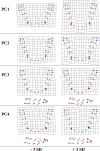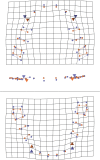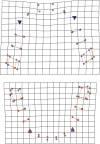Shape variation and covariation of upper and lower dental arches of an orthodontic population
- PMID: 25840587
- PMCID: PMC4914756
- DOI: 10.1093/ejo/cjv019
Shape variation and covariation of upper and lower dental arches of an orthodontic population
Abstract
Objectives: This study aimed to quantify the patterns of shape variability and the extent and patterns of shape covariation between the upper and lower dental arch in an orthodontic population.
Methods: Dental casts of 133 white subjects (61 males, 72 females; ages 10.6-26.6) were scanned and digitized in three dimensions. Landmarks were placed on the incisal margins and on the cusps of canines, premolars, and molars. Geometric morphometric methods were applied (Procrustes superimposition and principal component analysis). Sexual dimorphism and allometry were evaluated with permutation tests and age-size and age-shape correlations were computed. Two-block partial least squares analysis was used to assess covariation of shape.
Results: The first four principal components represented shape patterns that are often encountered and recognized in clinical practice, accounting for 6-31 per cent of total variance. No shape sexual dimorphism was found, nevertheless, there was statistically significant size difference between males and females. Allometry was statistically significant, but low (upper: R(2) = 0.0528, P < 0.000, lower: R (2) = 0.0587, P < 0.000). Age and shape were weakly correlated (upper: R(2) = 0.0370, P = 0.0001, lower: R (2) = 0.0587, P = 0.0046). Upper and lower arches covaried significantly (RV coefficient: 33 per cent). The main pattern of covariation between the dental arches was arch width (80 per cent of total covariance); the second component related the maxillary canine vertical position to the mandibular canine labiolingual position (11 per cent of total covariance).
Limitations: Results may not be applicable to the general population. Age range was wide and age-related findings are limited by the cross-sectional design. Aetiology of malocclusion was also not considered.
Conclusions: Covariation patterns showed that the dental arches were integrated in width and depth. Integration in the vertical dimension was weak, mainly restricted to maxillary canine position.
© The Author 2015. Published by Oxford University Press on behalf of the European Orthodontic Society. All rights reserved. For permissions, please email: journals.permissions@oup.com.
Figures








Similar articles
-
Dental archforms in dentoalveolar Class I, II and III.Angle Orthod. 2010 Sep;80(5):919-24. doi: 10.2319/112609-672.1. Angle Orthod. 2010. PMID: 20578864 Free PMC article.
-
Three-dimensional dental arch changes of patients submitted to orthodontic-surgical treatment for correction of Class II malocclusion.Dental Press J Orthod. 2014 Jul-Aug;19(4):71-9. doi: 10.1590/2176-9451.19.4.071-079.oar. Dental Press J Orthod. 2014. PMID: 25279524 Free PMC article.
-
Comparison of the dental arch changes in patients with different malocclusions.Indian J Dent Res. 2014 Sep-Oct;25(5):623-9. doi: 10.4103/0970-9290.147109. Indian J Dent Res. 2014. PMID: 25511063
-
Early developmental traits in class II malocclusion.Acta Odontol Scand. 1998 Dec;56(6):375-7. doi: 10.1080/000163598428356. Acta Odontol Scand. 1998. PMID: 10066120 Review.
-
Influence of heritability on occlusal traits: a systematic review of studies in twins.Prog Orthod. 2020 Aug 31;21(1):29. doi: 10.1186/s40510-020-00330-8. Prog Orthod. 2020. PMID: 32864724 Free PMC article.
Cited by
-
Relative contributions of genetic and environmental factors to palatal morphology: a longitudinal twin study.Eur J Orthod. 2024 Dec 4;47(1):cjae076. doi: 10.1093/ejo/cjae076. Eur J Orthod. 2024. PMID: 39704017 Free PMC article.
-
The Relationship between Unilateral Palatal Maxillary Canine Impaction and the Morphology of the Maxilla: A CBCT Study in Eastern Province of Saudi Arabia.Eur J Dent. 2023 Oct;17(4):1043-1050. doi: 10.1055/s-0042-1757567. Epub 2022 Dec 28. Eur J Dent. 2023. PMID: 36577439 Free PMC article.
-
Palatal vault morphometric analysis of the effects of two early orthodontic treatments in anterior open bite growing subjects: a controlled clinical study.BMC Oral Health. 2021 Oct 11;21(1):514. doi: 10.1186/s12903-021-01886-5. BMC Oral Health. 2021. PMID: 34635118 Free PMC article.
-
Fluctuating Genetic Influences at Three Different Stages of Development of Dental Arches: A Complex System.Genes (Basel). 2025 Feb 3;16(2):189. doi: 10.3390/genes16020189. Genes (Basel). 2025. PMID: 40004518 Free PMC article.
-
Morphological Comparison of the Maxillary Arch in Buccal and Palatal Canine Impaction among Asian Population of Gujarati Origin: A Hospital-Based Study.Healthcare (Basel). 2022 May 19;10(5):939. doi: 10.3390/healthcare10050939. Healthcare (Basel). 2022. PMID: 35628076 Free PMC article.
References
-
- Brader A.C. (1972) Dental arch form related with intraoral forces: PR=C. American Journal of Orthodontics, 61, 541–561. - PubMed
-
- Harris E.F. (1997) A longitudinal study of arch size and form in untreated adults. American Journal of Orthodontics and Dentofacial Orthopedics, 111, 419–427. - PubMed
-
- Braun S., Hnat W.P., Fender D.E., Legan H.L. (1998) The form of the human dental arch. The Angle Orthodontist, 68, 29–36. - PubMed
-
- Raberin M., Laumon B., Martin J.L., Brunner F. (1993) Dimensions and form of dental arches in subjects with normal occlusions. American Journal of Orthodontics and Dentofacial Orthopedics, 104, 67–72. - PubMed
-
- Lee R.T. (1999) Arch width and form: a review. American Journal of Orthodontics and Dentofacial Orthopedics, 115, 305–313. - PubMed
MeSH terms
LinkOut - more resources
Full Text Sources
Other Literature Sources

